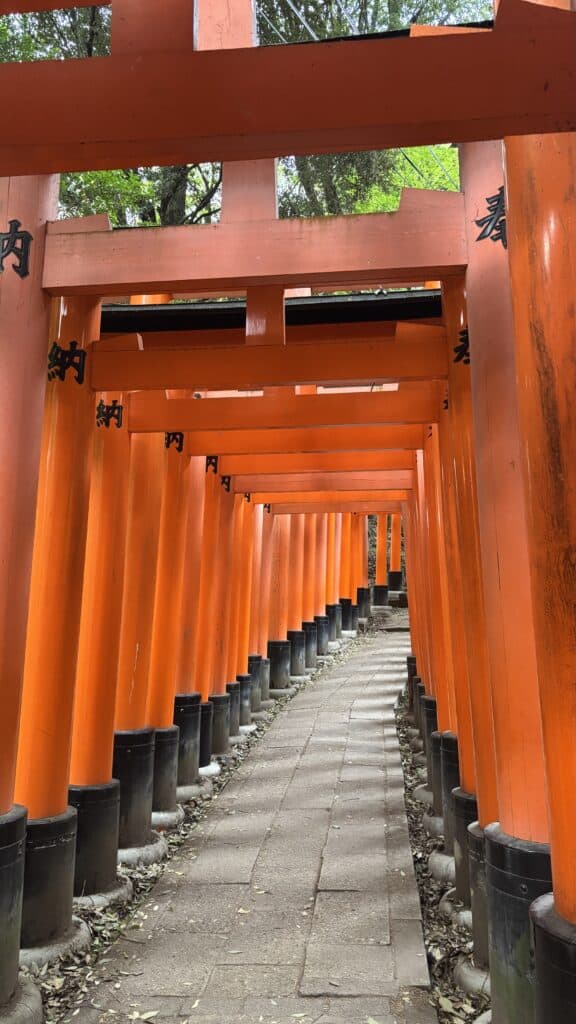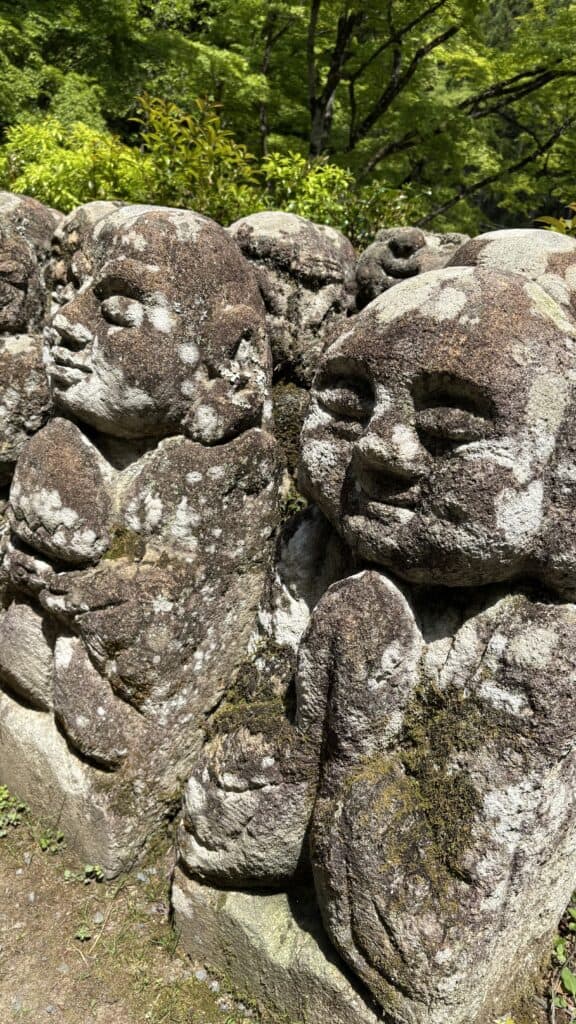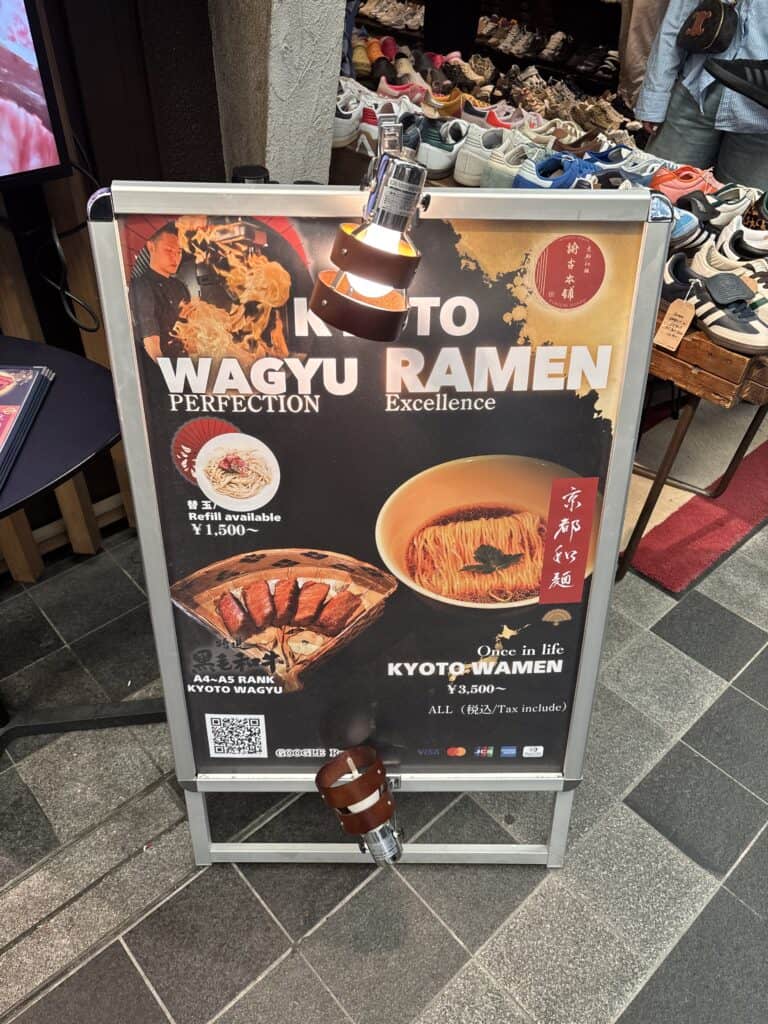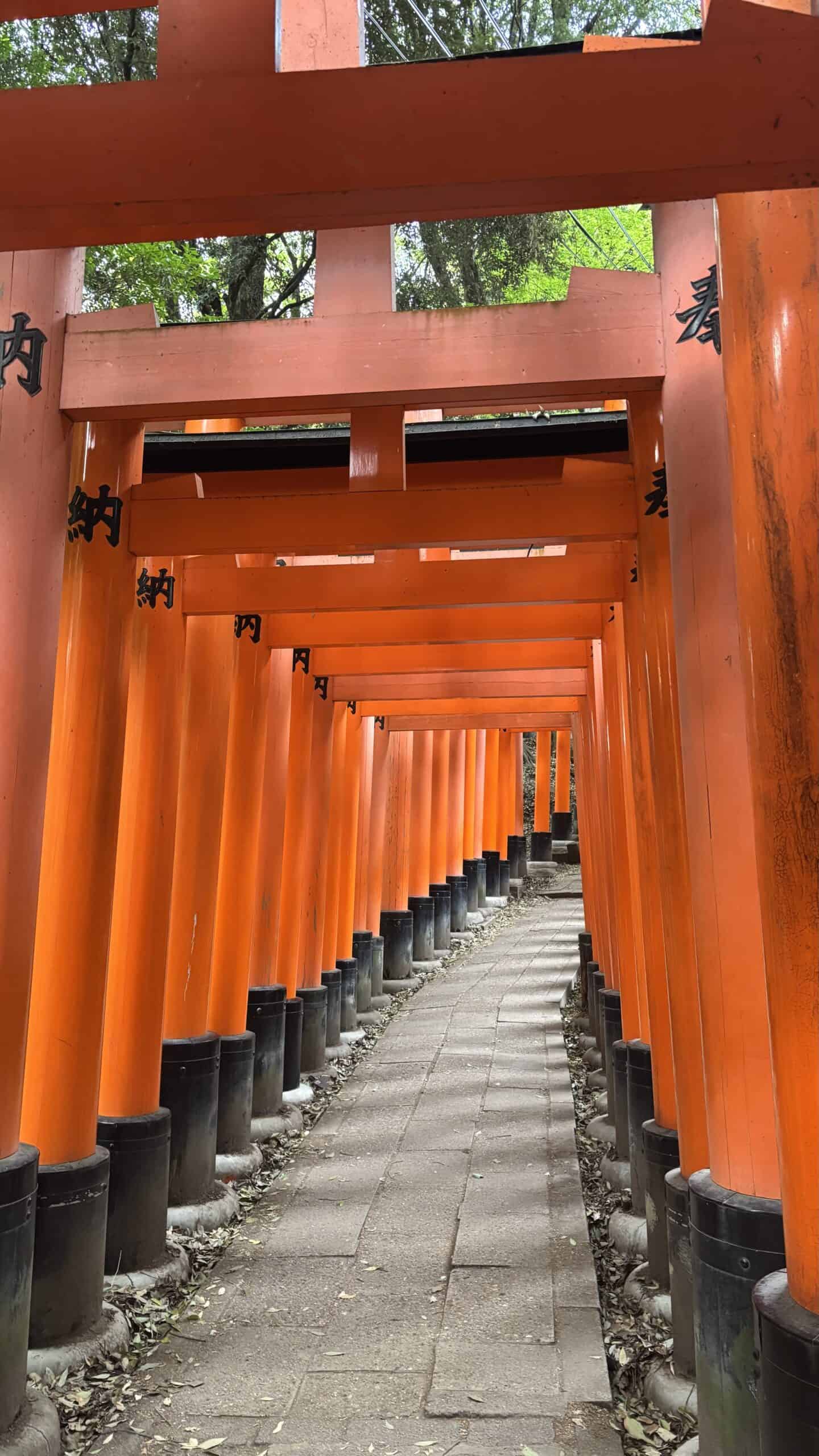Kyoto is the heart of Japanese culture – here you’ll find temples, traditional districts, teahouses, and bamboo forests. It’s truly a piece of history. The vibe of this city is completely different from futuristic Tokyo or lively Osaka.
Accommodation Tip:
It’s ideal to combine two types of accommodation. Try a traditional Ryokan (Japanese: 旅館), a traditional Japanese inn that emphasizes Japanese customs and traditions. There are over 80,000 ryokans in Japan, ranging from luxurious hotels to small family-run guesthouses. We stayed at Nissho Besso, conveniently located near the subway and Nishiki Market. It’s also within walking distance of Gion, but we chose a second accommodation there because, for a nice photo at Yasaka Pagoda – Hōkan-ji Temple and Ninezaka walkway, you really have to go early in the morning to avoid the crowds.
🏯 Most Famous Temples and Shrines
Fushimi Inari Taisha
- Famous for its thousands of orange torii gates leading up the hill.
- Magical place – go early in the morning or later in the afternoon to avoid crowds. The upper sections are ideal for photography, as most tourists don’t venture there due to the many stairs.

Kinkaku-ji (Golden Pavilion)
- Kinkaku-ji (Japanese: 金閣寺, literally “Temple of the Golden Pavilion”) is one of the most famous and visited landmarks in Japan, located in the northwest part of Kyoto as part of the Rokuon-ji Buddhist temple complex.
- History:
- Originally, an aristocratic villa of the Saionji clan stood here during the Kamakura period.
- In 1397, shogun Ashikaga Yoshimitsu purchased the site and built his residence Kitayamadono with the central Golden Pavilion.
- After Yoshimitsu’s death, the residence was converted into a Rinzai Zen Buddhist temple by his son.
- The complex was destroyed by fire several times, especially during the Ōnin War (1467–1477), and the Golden Pavilion was last burned down in 1950 by a mentally ill monk.
- The current pavilion dates from 1955, when it was faithfully reconstructed and again covered in gold.
- Architecture and Symbolism:
- The Golden Pavilion is a three-story building, with the top two floors completely covered in thin sheets of pure gold (0.5 μm thick).
- Each floor represents a different architectural style:
- First floor: shinden-zukuri (aristocratic Heian style)
- Second floor: buke-zukuri (samurai style)
- Third floor: zenshū butsudō (pure Zen architecture)
- On the roof sits a golden Chinese phoenix (hōō), symbolizing immortality and renewal.
- Inside the pavilion are Buddha relics.
- The gold is not only aesthetic but also deeply symbolic – it is believed to purify the soul from negative thoughts about death and reflects sunlight, creating a stunning image in the adjacent pond.
- Garden and Surroundings:
- The pavilion stands on the shore of the “mirror pond” Kagamiko, whose surface reflects the pavilion, creating an iconic view, especially at sunrise and sunset.
- The garden is designed according to Japanese landscape architecture principles, with all elements (buildings, stones, islands, waterfalls) placed to respect the flow of ki (life energy).
- A notable feature is the old pine tree Rikusyu-no-matsu, whose branches resemble a boat.
- Cultural Significance:
- Kinkaku-ji is a UNESCO World Heritage Site as part of the “Historic Monuments of Ancient Kyoto.”
- The 1950 arson inspired the famous novel “The Temple of the Golden Pavilion” by Yukio Mishima.
- The temple is a symbol of Japanese aesthetics, philosophy, and attitudes toward death and impermanence.
- Visitor Info:
- Visitors can access only the garden; the pavilion itself is closed to the public.
- The best views are during autumn foliage or at sunset.
- Kinkaku-ji is not only an architectural gem but also a profound symbol of Japanese culture, aesthetics, and spirituality, attracting hundreds of thousands of visitors from around the world every year.
Ginkaku-ji (Silver Pavilion)
- Less ostentatious, but a beautiful garden complex with scenic views.
- Starting point of the Philosopher’s Path – a pleasant walk along the canal.
Kiyomizu-dera
- An iconic temple in the heart of Kyoto with breathtaking city views, built without a single nail. A magical place blending history, nature, and traditional Japanese architecture. Again, it’s best to arrive early.
- Kiyomizu-dera (清水寺, “Pure Water Temple”) is one of the most significant and visited Buddhist temples in Kyoto, a UNESCO World Heritage Site. Located on the eastern edge of the city in the Higashiyama district, it was founded in 778 and named after the famous Otowa waterfall, whose water is considered sacred and brings good luck, longevity, and success.
- The temple’s most famous feature is its large wooden terrace (“Kiyomizu Stage”), which juts 13 meters above the hillside and offers impressive views of Kyoto and the surrounding nature, especially during cherry blossom and autumn leaf seasons. The terrace and main hall were built without using a single nail, showcasing the mastery of traditional Japanese architecture. The main object of worship is a statue of the eleven-headed, thousand-armed Kannon, displayed to the public only on special occasions.
- The temple complex also includes the Jishu Shrine, dedicated to the deity of love, and more than 30 other temple buildings and gardens. Kiyomizu-dera is sought after for its historical and spiritual value, its harmony with nature, and its unique atmosphere, attracting visitors from all over the world.
Otagi Nenbutsu-ji Temple
- Otagi Nenbutsu-ji (愛宕念仏寺) is a Buddhist temple on a hillside in western Kyoto, in the Arashiyama area. The temple is especially known for more than 1,200 stone statues of arhats (rakan), disciples of Buddha, covered in moss and scattered around the slopes, creating a unique and tranquil atmosphere.
- History:
- Founded in 766 by Empress Shōtoku in the Gion area of Kyoto. Over the centuries, it was repeatedly destroyed by floods and wars and gradually fell into disrepair.
- In 1922, it was moved to its current location in Arashiyama to preserve its main building.
- In 1950, the temple suffered severe damage during a typhoon.
- In 1955, Kocho Nishimura became the temple’s head priest and started extensive renovations. Most of today’s arhat statues were created during a decade-long reconstruction in the 1980s.
- Arhat Statues:
- The main attraction is the 1,200 stone arhat statues, created by laypeople and visitors under Nishimura’s guidance. Each statue is unique – some depict praying figures, others are smiling, playing musical instruments, or have other distinctive features reflecting the interests and personalities of their creators.
- Among the statues, you’ll find musicians, animal lovers, or friends sitting together – no two statues are alike.
- Atmosphere and Visit:
- The entrance gate is guarded by two Nio statues, and inside, visitors are surrounded by hundreds of arhats.
- The temple is relatively remote and not heavily visited by tourists, so it offers a peaceful and pleasant atmosphere.
- Otagi Nenbutsu-ji is ideal for those seeking an unconventional Kyoto experience away from the main tourist routes.
- History:

🎋 Nature & Peaceful Zones
Arashiyama & Bamboo Grove
- Picturesque district in western Kyoto, famous for its bamboo grove.
- Tenryu-ji Temple, boat rides on the Hozugawa River, and the option to take the romantic Sagano train.
- Highly recommended to visit in the morning. You can also visit Adashino Nenbutsu-ji Temple nearby, which has a small bamboo grove perfect for photos (but don’t expect a huge forest – the real one is only in Arashiyama). While in the area, walk to Otagi Nenbutsu-ji Temple to see over 1,200 stone arhat statues (details above).
Philosopher’s Path (Tetsugaku no Michi)
- A peaceful walking path between Ginkaku-ji and Nanzen-ji temples along a canal.
- Especially beautiful in spring (cherry blossoms) and autumn (colorful leaves).
🏘️ Traditional Atmosphere and Culture
Gion
- Geisha district – in the evening, you might see a geisha (if you’re lucky, as there are few real ones left) or a maiko moving between teahouses.
- Wooden alleys, teahouses, restaurants – the real old Kyoto.
Higashiyama
- Traditional area between Kiyomizu-dera and Gion, old streets (Ninenzaka, Sannenzaka), very popular and crowded, so go early.
- Perfect place to rent a kimono and take a walk.
Nishiki Market – best for rainy days
- Indoor market with traditional foods, souvenirs, and street food.
- Ideal for lunch or tasting local specialties. There are also many shops and second-hand stores.
- Ramen or wagyu? Try Wamen! It was great.

🧘♂️ Other Sights and Activities
- Nijo Castle – shogun residence with “nightingale” floors.
- Kyoto Imperial Palace – extensive complex and gardens, free entry.
- Tea ceremony – book a traditional ceremony (e.g., in Gion).
- Kimono experience – kimono rentals with photo shoots and walks.
- Kyoto International Manga Museum – paradise for manga fans.
📍 Map Overview (for orientation):
- East: Fushimi Inari, Gion, Kiyomizu-dera, Higashiyama
- North: Kinkaku-ji, Ginkaku-ji, Philosopher’s Path
- West: Arashiyama
- Center: Nishiki Market, Nijo Castle, Imperial Palace
⏱️ Time Recommendations
- 1 day: Fushimi Inari → Kiyomizu-dera → Gion → evening walk
- 2 days: Add Kinkaku-ji, Ginkaku-ji, Philosopher’s Path
- 3 days: Full day in Arashiyama + Tenryu-ji Temple, bamboo grove, river cruise
- Or any other combination 🙂 We stayed for 5 nights.
On the last day, we left for Nara early in the morning. We took our suitcases with us, as we went straight from Nara to Osaka. The connection is easy via local trains, so you actually save one trip. You can leave your luggage at Nara station in a coin locker. It costs about 1,500 yen (we took a large locker and fit all our things in it). See you in Nara next time!

